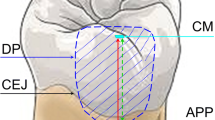Abstract
Objectives:
The aim of this in-vitro study was to evaluate initial bond strength in Newton (N) of two types of wires (Ortho- Flextech™ chain and Penta-One™ Coaxial wire 0.0215") bonded with three lingual retainer composites (FlowTain™, Light Cure Retainer™ and Transbond™ LR).
Materials and Methods:
One hundred and eighty sound, extracted human premolars were randomly divided into six equal groups. One of the two types of lingual retainer wires was bonded with one of the three types of the composite material in each group. Initial bond strength was measured using an Instron universal testing machine. We also evaluated the failure characteristics after failure at maximum load using an optical microscope.
Results:
Our findings demonstrated that the Coaxial/Transbond™ LR group was statistically significantly stronger than the other combinations. Statistically, 0.0215" Coaxial wire provided significantly stronger bond strength than Ortho-Flextech™ chain, and when the three composite systems were compared, Transbond ™ LR revealed significantly higher bond strength than the others. However, Transbond™ LR left significantly more resin on the enamel surface after bond failure.
Conclusion:
Significant differences exist between different combinations of wires and lingual retainer composites; however, all the wire-and-composite combinations we tested possess sufficient bond strength for clinical application.
Zusammenfassung
Ziel:
In einer In-vitro-Studie wurde die initiale Verbundfestigkeit [N] zweier Drahttypen (Ortho-Flextech™-Kette und Penta-One™- Coaxial-Draht 0.0215") in Verbindung mit drei für Lingualretainer gebräuchlichen Kompositen (FlowTain™, Light Cure Retainer™ and Transbond™ LR) getestet.
Material und Methodik:
Hundertachtzig extrahierte gesunde menschliche Prämolaren wurden nach dem Zufallsprinzip in sechs gleichgroße Gruppen aufgeteilt. In jeder Gruppe wurde einer der beiden Drahttypen mit einem der drei Kompositmaterialien geklebt. Die initiale Verbundfestigkeit wurde mittels einer Instron- Universalprüfmaschine untersucht. Zusätzlich wurden mit einem Lichtmikroskop die Bruchcharakteristika nach Abriss bei maximaler Kraft untersucht.
Ergebnisse:
Die Coaxial/Transbond™-LR-Verbindung war statistisch signifikant stabiler als die anderen Draht-Komposit-Kombinationen. Der Statistik nach erbrachte der 0.0215-Coaxial-Draht signifikant bessere Haftwerte als die Ortho-Flextech™-Kette, und im Vergleich der drei Kompositkleber war die Verbundfestigkeit des Transbond™-LR-Klebers signifikant am höchsten. Allerdings verblieb beim Transbond™ LR nach Bruch des Klebeverbundes auch der signifikant größte Anteil an Restkunststoff auf der Schmelzoberfläche.
Schlussfolgerung:
Zwischen den einzelnen Draht-Kompositkleber- Kombinationen bestehen signifikante Unterschiede; jedoch ergab sich bei allen getesteten Kombinationen eine für die klinische Anwendung ausreichende Verbundfestigkeit.
Similar content being viewed by others
References
Al-Sehaibany F, Al-Emran S, Al-Khatani F, et al. Bond strength of two techniques for bonding lingual orthodontic retainer. Saudi Dent J 2006;18:120–4.
Årtun J, Spadafora AT, Shapiro PA. A three-year follow up study of various types of orthodontic canine-to-canine retainers. Eur J Orthod 1997;19:501–9.
Bearn DR, McCabe JF, Gordon PH, et al. Bonded orthodontic retainers: the wire-composite interface. Am J Orthod Dentofacial Orthop 1997;111:67–74.
Dahl EH, Zachrisson BU. Long-term experience with direct-bonded lingual retainers. J Clin Orthod 1991;25:619–30.
Diamond M. Resin fiberglass bonded retainer. J Clin Orthod 1987;21:182–3.
Little RM, Wallen TR, Riedel RA. Stability and relapse of mandibular anterior alignment-first premolar extraction cases treated by traditional edgewise orthodontics. Am J Orthod 1981;80:349–65.
Little RM, Riedel RA, Årtun J. An evaluation of changes in mandibular anterior alignment from 10 to 20 years post retention. Am J Orthod Dentofacial Orthop 1988;93:423–8.
Little RM, Riedel RA. Postretention evaluation of stability and relapse- mandibular arches with generalized spacing. Am J Orthod Dentofacial Orthop 1989;95:37–41.
Little RM. Stability and relapse of dental arch alignment. Br J Orthod 1990;17:235–41.
Littlewood SJ, Millett DT, Doubleday B, et al. Retention procedures for stabilising tooth position after treatment with orthodontic braces. Cochrane Database of Systematic Reviews 2006, Issue 1. Art. No.: CD002283. DOI: 10.1002/14651858.CD002283.pub3.
Lumsden KW, Saidler G, McColl JH. Breakage incidence with direct bonded lingual retainers. Br J Orthod 1999;26:191–4.
Oesterle LJ, Shellhart WC, Henderson S. Enhancing wire-composite bond strength of bonded retainers with wire surface treatment. Am J Orthod Dentofacial Orthop 2001;119:625–31.
Orchin JD. Permanent lingual bonded retainer. J Clin Orthod 1990;24:229–31.
Sinclair PM, Little RM. Maturation of untreated normal occlusions. Am J Orthod 1983;83:114–23.
Radlanski RJ, Zain ND. Stability of the bonded lingual wire retainer: a study of the initial bond strength. J Orofac Orthop 2004;65:321–35.
Reynolds IR. A review of direct orthodontic bonding. Br J Orthod 1975;2:171–8.
Rose E, Frucht S, Jonas IE. Clinical comparison of a multistranded wire and a direct-bonded polyethylene ribbon-reinforced resin composite used for lingual retention. Quintessence Int 2002;33:579–83.
Waters NE. Some mechanical and physical properties of teeth. Symp Soc Exp Biol 1980;34:99–135.
Zachrisson BU. Clinical experience with direct-bonded orthodontic retainers. Am J Orthod 1977;71:440–8.
Zachrisson BU. JCO/interviews Dr. Bj:orn U. Zachrisson on excellence in finishing. Part 2. J Clin Orthod 1986;20:536–56.
Zachrisson BU. Third-generation mandibular bonded lingual 3-3 retainer. J Clin Orthod 1995;28:39–48.
Author information
Authors and Affiliations
Corresponding author
Rights and permissions
About this article
Cite this article
Aldrees, A.M., Al-Mutairi, T.K., Hakami, Z.W. et al. Bonded Orthodontic Retainers: A Comparison of Initial Bond Strength of Different Wire-and-Composite Combinations. J Orofac Orthop 71, 290–299 (2010). https://doi.org/10.1007/s00056-010-9947-5
Received:
Accepted:
Published:
Issue Date:
DOI: https://doi.org/10.1007/s00056-010-9947-5




